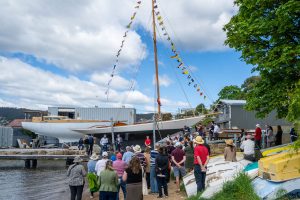Can coal survive the solar spread? Major Australian power plant notches ‘extraordinary’ first

- by Admin
- October 12, 2024
After years of setbacks, bad news and mounting obstacles, Australia’s coal-fired generators must have felt they had something to celebrate.
AGL, the giant energy company backed by tech billionaire and climate evangelist Mike Cannon-Brookes, revealed it had pulled off a first.
At its huge Bayswater power station in the Hunter Valley north of Sydney, AGL successfully switched off an entire unit before switching it back on again just five hours later – a feat until recently considered unthinkable.
In a post on social media, Bayswater general manager Len McLachlan said this process of “two-shifting” was a harbinger of the future.
Throughout its history, coal-fired power had been considered the quintessential provider of so-called base-load electricity.
The term refers to generation sources that run round-the-clock, throughout the year and more or less at their full capacity.
It was a function that coal plants had carried out for decades, and a business model on which the industry was built.
The rise and rise of rooftop solar in Australia has been breathtaking. (ABC News: Glyn Jones)
But, more and more, base-load coal plants have been squeezed out of the market as ever more renewable energy – particularly solar power – flooded the system.
In doing so, renewable energy was forcing wholesale prices ever lower – so low that they were entering negative territory where generators had to pay to keep producing.
And while coal plants – despite the orthodox thinking – could in fact reduce their output to minimise their exposure to those low or negative prices, they were only able to lower production so much.
Beyond that, the industry had claimed, it was technically unsafe and economically unsound to operate coal plants designed to run full steam.
That was, until now.
Times, and coal, are a-changin’
Two-shifting, Mr McLachlan said, was a way for coal plants to capitalise on high prices in the evening peak while avoiding bearish prices in the middle of the day when solar power was most abundant.
It was a way to give flexibility to a type of generation that was not designed to be flexible.
Mike Cannon-Brookes. (AAP: Dan Himbrechts)
“Bayswater power station achieved a major milestone recently with the successful completion of our first two-shift trial,” Mr McLachlan wrote.
“Our team desynchronised 20 seconds ahead of the 10am target and re-synchronised within 50 seconds of the 3pm target.
“This level of precision on our first attempt is extraordinary and sets a new benchmark for our operations.”
David Leitch, an energy industry analyst, said it was a significant achievement by AGL.
“The general presumption has been that coal-fired generation units, which are very large units … have a minimum operating rate below which they can’t run,” Mr Leitch said.
“The presumption was that when you turned them off you then had to let them cool down and start them up fairly gradually.
“You couldn’t stop and start them in the same way that you could with a gas generator, for instance, let alone a battery that can change direction in milliseconds.
“But the exciting news out of Bayswater is that it can now be turned off and on within a 24-hour cycle on a continuous basis without damaging anything very much.
“It’s a very positive result all around.”
Mr Leitch said that on top of the financial savings for their owners, switching off coal plants in the middle of the day would also cut emissions and make more room for renewable energy.
The floor below which coal output could not drop is seen by industry players as an impediment to Australia’s energy transition – a cause to waste huge amounts of cheap wind and solar output at certain times.
These times are most obvious in the middle of the day when solar output is highest, particularly in autumn and spring, when relatively mild weather means demand for power can be subdued.
“It’s only still only experiments at this stage,” he said.
“Assuming they do get confidence … the minimum generation level of coal could theoretically fall all the way to zero.”
Now comes the bad news
But mere days after AGL’s announcement of the good news, another Australian coal-fired generator painted a bleaker, arguably truer, picture for the industry.
Delta, the Czech firm that owns the aging Vales Point coal plant near Lake Macquarie, reported that it had been unable to get the financial backing of any major bank in Australia.
And Delta, like any other generator in the national electricity market covering Australia’s eastern seaboard, needs financial backing from the banks.
Vales Point Power Station (ABC News: Ben Millington)
Each day, the generators are producing and selling vast quantities of electricity, trading with customers more or less continuously.
To cover periods where a company like Delta might sell power at a loss and incur any debts, the Australian Energy Market Operator requires generators to provide credit support in the form of a bank guarantee.
But Delta, in a letter written to the body that makes the rules in the market, said none of the 15 banks it had met had been willing to provide it the necessary coverage because of environmental concerns.
As a result, the company was in a quandary.
When the support from its current bank expired later this year, Delta said it would be unable to meet the funding requirements from AEMO even though, it insisted, it had the money.
“A significant number of financial institutions, that would be acceptable to AEMO, are no longer providing financing facilities to fossil fuel generators,” the company wrote in its letter.
“While the energy transition is progressing, there will be an ongoing reliance on fossil fuel generators, at least in the immediate future.
“It has been identified during the refinancing process that 13 of the 15 lenders declined due to (environmental, social and governance) constraints, which included the Big-4 Australian banks.
“There exists a real potential that a market participant, while being a profitable and solvent business, may be unable to meet prudential requirements with AEMO from the end of 2024.”
Macquarie is reported to be Delta’s current lender, but that support will dry up at year’s end. (Reuters: David Gray)
The company wants the rules urgently changed so AEMO can accept cash payments instead of a bank guarantee.
Failure to do so, Delta warned, could lead to inefficient outcomes – or worse.
“Without the option of providing cash as credit support, (it) is likely to result in severe reliability and security issues,” it wrote.
“At worst … critical generation assets are forced to withdraw from the market or are removed from participating in the market by AEMO because of an inability to meet prudential requirements through a bank guarantee.”
Czech group Sev.en reportedly spent more than $200 million on Vales Point in 2022 when they bought it off businessmen Trevor St Baker and Brian Flannery, who famously paid just $1 million for the asset in 2015.
Under Sev.ev’s plans, it extended the life of Vales Point from 2029, when it had been due to shut, to 2033.
Coal’s future ‘nailed shut’
Energy analyst Mr Leitch, who owns consultancy ITK Services, said Delta’s problems were, to a large extent, of its own making.
Mr Leitch, a former investment banker, said the company was seemingly indifferent to the push to decarbonise, or lay out a credible play to do so.
He said this flew in the face of the demands on banks, which were under growing pressure to stop lending to fossil fuel projects or firms without decarbonisation plans.
“It’s exacerbated in Delta’s case because they are very unashamedly totally pro-coal,” Mr Leitch said.
“They’ve got no plans to decarbonise or do anything.
“So it makes it very hard for anyone who is under pressure themselves about climate change goals – which the banks all are – to continue supporting a business that refuses to even acknowledge the reality of it.”
Wind power is being wasted because rooftop solar is uncontrolled and coal can only go so low. (ABC News: Daniel Mercer)
In the short term, Mr Leitch said Delta was likely to win a reprieve and be given the rule change it was after.
He said the business “actually has cash and can provide those guarantees – they don’t actually need the banks, it’s just been a legal or AEMO requirement”.
“For me, the broader issue is that the pressure from the banks, and I think it will come from the insurance companies as well, is increasing all the time.
“By and large, most of the finance industry, particularly people investing in the future and the longer term, take climate change in general very seriously and feel like they have to get on with the task of doing something about it.
“And, so, they exert pressure.”
Longer term, Mr Leitch said the plight of AGL and Delta, while different in many ways, shared common ground in one, crucial way.
He said the financial screws were getting tighter on the coal-fired power industry, and this was unlikely to change.
According to Mr Leitch, measures like two-shifting at Bayswater may help extend the life of some coal plants, at least for a time.
And he said it even opened up the possibility of coal plants being left on care-and-maintenance after they retired from full-time service – of using them as back-up generators when the system needed the help.
But, ultimately, he said the writing was on the wall for coal power as we know it.
“The coal-fired generation is going to go out of business in Australia over the next 10 years,” he said.
“Nearly everyone accepts that.
“It’s absolutely locked in that the coal generation in Australia is going away and it’s only the same as is happening all over the world.”
AGL’s Bayswater coal plant is at the forefront of efforts to keep the fuel viable in a solar world. (Reuters: Mick Tsikas)
The Latest News
-
November 16, 2024McSweeney selection shows that Australian selectors backed themselves into a corner: Hayden
-
November 16, 2024‘Chomping at the bit’: Aussie quick seizes rare chance as Pakistan targets SCG comeback – LIVE
-
November 16, 2024Aussie rules giant Zach Tuohy: ‘How could you, in all good conscience, try and stop young players doing what I did?’
-
November 16, 2024‘Slap in the face’: Stadium boss’s warning to Cricket Australia after years of tension
-
November 16, 2024AFL launches AFL Open for special needs players | Sporting News Australia



